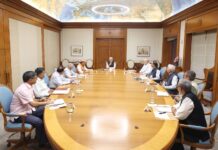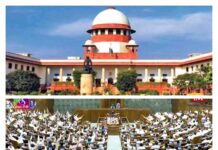
दिल्ली
केंद्रीय केबिनेट ने आज नोएडा और ग्रेटर नोएडा के बीच बन रहे मेट्रो रेल लाइन को मंजूरी दे दी। हालांकि मेट्रो लाइन का काम पहले से ही चल रहा है लेकिन केबिनेट की मंजूरी मिलने के बाद मेट्रो प्रोजेक्ट को केंद्र सरकार का तरफ से मिलने वाली रकम मिल सकेगी। इस मेट्रो लाईन की लंबाई 29.7 किमी है और इसके पूरा होने में कुल 5503 करोड़ रुपए की खर्च का अनुमान है। नोएडा-ग्रेटर नोएडा मेट्रो प्रोजेक्ट को पूरा करने के लिए अप्रैल 2018 का टारगेट रखा गया है। इस मेट्रो प्रोजेक्ट के पूरा होने से के बाद नोएडा और ग्रेटर नोएडा आने जाने में आसानी होगी , समय की बचत होगी और दिल्ली से डायरेक्ट ग्रेटर नोएडा मेट्रो से जाया जा सकेगा।
Press Release–
The Union Cabinet chaired by the Prime Minister Shri Narendra Modi has approved the Noida – Greater Noida Metro Rail Project covering a length of 29.707 k.m. Total completion cost of the project is Rs.5,503 crore.
Metro rail connection between NOIDA and Greater NOIDA will result into people being assured about their mobility and thus more people will like to move to these satellite towns of Delhi, thus decongesting Delhi. As a result, more residential and commercial complexes will develop in this region. With metro rail in place, there will be less vehicular traffic on roads leading to less congestion, less time and cost of journey, less consumption of fossil fuel and less environmental pollution. People of Noida-Greater Noida, which has a population of approx. 7.50 Lakhs and people of surrounding areas will be benefitted with this metro link.
Project will be implemented by Noida Metro Rail Corporation Limited, which will be a 50:50 jointly owned company of Govt. of India and Govt. of Uttar Pradesh. The existing Noida Metro Rail Corporation Limited (NMRCL) which is a State owned Special Purpose Vehicle (SPV) will be converted into a joint SPV of Government of India (Gol) and Government of Uttar Pradesh (GoUP), for implementation of the project.
The project would generate significant direct and indirect employment of skilled, semi-skilled and unskilled workforce. Substantial indirect employment will also be generated during construction and operation phases.
The project is scheduled to be completed by April, 2018 as per the Detailed Project Report (DPR). About 70% progress of civil work and 40% of overall financial progress of the project have been achieved.
Project will be covered under the legal framework of Central Metro Acts, Metro Railways (Construction of Works) Act, 1978 and the Metro Railways (Operation and Maintenance) Act, 2002, as amended from time to time.

केंद्रीय केबिनेट ने बुधवार को गन्ने का न्यूनतम समर्थन मूल्य बढाने को भी अपनी मंजूरी दे दी। 2017-18 के गन्ना खरीद सीजन के लिए गन्ने का उचित एवं लाभदायक मूल्य यानि FRP को 25 रुपए की बढोत्तरी के साथ 255 रुपए प्रति क्विंटल करने का फैसला किया। मौजूदा सीजन 2016-17 के लिए FRP 230 रुपया प्रति क्विंटल था। हालांकि गन्ने के FRP में बढोत्तरी के बाद ये आशंका जताई जा रही है कि इससे चीनी की कीमतों बढेंगी।
FRP वह न्यूनतम मूल्य होता है जितना गन्ना किसानों को देना उनका कानूनी अधिकार होता है हांलाकि राज्य सरकारें अपने मुताबिक दरें भी तय कर सकती है। पर अमूमन राज्य सरकारों की तरफ से तय किया गया SAP(राज्य परामर्श मूल्य ) FRP से ज्यादा होता है।
Press Release–
The Cabinet Committee on Economic Affairs, chaired by the Prime Minister Shri Narendra Modi, has given its approval for fixing the Fair and Remunerative Price (FRP) of sugarcane at Rs. 255/- per quintal (qt) for sugar season 2017-18 linked to a basic recovery rate of 9.5% subject to a premium of Rs. 2.68 per qtl for every 0.1% point increase in recovery above that level. The approved FRP reflects an increase of 10.87% over the FRP of sugar season 2016-17. The FRP so approved shall be applicable for purchase of sugarcane from the farmers in the sugar season 2017-18 by the sugar mills. The move is a reflection of the Government’s pro-farmer initiatives, keeping in mind the interest of sugarcane farmers and importance of the sugar industry.
Details
The sugar industry is an important agro-based industry that impacts the livelihood of about 50 million sugarcane farmers and around 5 lakh workers directly employed in sugar mills, apart from those employed in various ancillary activities including farm labour and transporters. This decision has been taken to provide appropriate price to the farmers for their cane.
FRP of sugarcane has been determined on the basis of recommendations of Commission for Agricultural Costs and Prices (CACP) and after consultation with State Governments and other stake-holders. Recommended FRP has been arrived at by taking into account various factors such as cost of production, overall demand-supply situation, domestic and international prices, inter-crop price parity, terms of trade prices of primary by-products, and likely impact of FRP on general price level and resource use efficiency.
During the last 3 years, in order to support the sugarcane farmers and to ensure that their dues are paid by the sugar mills, the Government of India introduced schemes such as SEFASU; Soft Loan, Incentive for Raw Sugar Export and Production Subsidy. Through these interventions, the funds made available to the mills were utilized for payment of the cane price arrears of the farmers. Direct credit into the farmers’ bank accounts of their dues was also mandated.
As a consequence, clearance of cane price arrears of farmers reached 99.33% for 2014-15 sugar season and 98.5% for 2015-16 sugar season. Cane price arrears for the current sugar season 2016-17 is the lowest as compared to last five years of the corresponding period.
In order to address the current sugar season’s shortfall in production and any possible adverse price sentiment, the Government has allowed import of only 5 lakh MT of raw sugar at zero duty. However, to protect the Indian farmers, import quantity has been restricted along with zonal restrictions so as to make it available only in actually deficient areas and safeguard the interest of cane farmers.

















